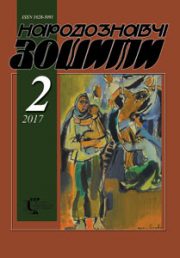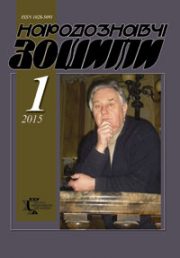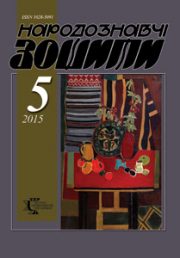The Ethnology Notebooks. 2020. № 1 (151), 177—189
UDK7.071.5: 37: 316.36: 159.924.7
DOI https://doi.org/10.15407/nz2020.01.177
GAVRYLYUK Alla
ОRCID ID: https://orcid.org/0000-0002-6833-6462
Postgraduate student, Kyiv National
University of Culture and Arts,
36, Evgeni Konovalets str., 01133, Kyiv, Ukraine,
Contacts: e-mail: alla_stepp@ukr.net
Abstract. The purpose of the article is to give an answer on the still relevant questions: What is the ratio of the natural gift and family transmission, innate and acquired? What prevails in the artistic dynasties — the development and imitation of the closest examples, or the creation of a new, craft or inspiration? For similar questions one does not have to look for an unambiguous answer, because each genus is special, especially if the genre is artistic. Given problem is highlighted by the example of the ancestors and descendants of a well known researcher of Ukrainian folk art M.R. Selivatchov.
Our study is based on the documents from the archives and on the numerous publications about the family’ representatives with applying mostly biographic method. We shall start from Katerina Selivatchova (1864 — after 1911). She is an author of several oil pictures and graphic works, reproduced at the many postcards and books. Her son, Alexey Selivatchov (1887—1919), taught at the Vilna’ gymnasium language and literature to Mikhail Bakhtin and wrote his thesis under the tutelage of the Kharkiv’ Academician Nikolai Sumtsov. In the Selivatchov’ printed works issues of literary and linguistics, philosophy, and religion are studied from the point of emerging in those days phenomenology. His son Roman (1914—1995) was an artist in the field of polygraphy. Next three family’ generations are also connected with art.
Our main conclusions should be formulated in such a way: the family tradition may give the child cultural soil, along with a school education. Nevertheless, the most important is the personal natural inclination, since children of the same parents do not always choose the same profession or activity. On the other hand, while clearly «brought up by education» it appears more noticeable than mysterious «innate talent», but there are things too in the arts that cannot be taught. A family can teach parenting crafts, but more importantly in a changing world, it is not so much having specific knowledge and skills as being able to always inspire, constantly learn, discover talented, whether new or forgotten. to preserve the children’s ability to admire, marvel, and pass on this impulse to others.
Keywords: acquired ability, artistic dynasties, family transmission, innate ability, natural endowment.
Received 20.01.2020
REFERENCES
Center for genealogical research. Electronic resource. Access mode: Retrieved from: http://rosgenea.ru/?alf=18&serchcatal=%D1%E5%EB%E8%E2%E0%F7%E5%E2&r=4 [in Russian].
Koretsky, V.I. (1959). Zemsky Council of 1575 and the staging of Simeon Bekbulatovich «The Grand Prince of All Russia». Historical archive, 2, 148—156. Access mode: http://www.vostlit.info/Texts/Dokumenty/Russ/XVI/1560-1580/Zemsk_sobor_1575/text.htm. [in Russian].
The Russian State Archive of Literature and Art. Foundation 660. List. F. 660. Op. 1. Systematization sections of the inventory. Correspondence of members of the Society, their relatives and other persons with the Society. Storage unit. F. 660. Op. 1. Unit hr 953. Code: F. 660. Op. 1. Unit hr 953 [in Russian].
Monuments of Kaluga. 4 generations of a family. Access mode: Retrieved from: https://opk2.fosite.ru/wiki/196198_%D0%BF%D0%B0%D0%BC%D1%8F%D1%82%D0%BD%D0%B8%D0%BA%D0 % B8_% D0% 9A% D0% B0% D0% BB% D1% 83% D0% B3% D0% B8 / 544904_4_% D0% BF% D0% BE% D0% BA% D0% BE% D0% BB% D0 % B5% D0% BD% D0% B8% D1% 8F_% D1% 81% D0% B5% D0% BC% D1% 8C% D0% B8? fbclid = IwAR01P8jX4Q3NhAPczlWIryGovYBUf862TFQwykKgyhv-ZTo8klW2bzYI6iE? fbclid = IwAR01P8jX4Q3NhAPczlWIryGovYBUf862TFQwykKgyhv-ZTo8klW2bzYI6iE # [in Russian].
For a Help to Women Students (1901). Moscow: Typo-lithogr. T-va I.N. Kushneryov and Co. Іnformation is duplicated in the book: Tonchu, E. (2004). Russia. Women’s fate. Century XXI. 528 р. (Pp. 395—396). Moscow [in Russian].
Antonova, M.S. (2019). Record of N.V. Gogol in the album of I.P. Postnikov: on the issue of attribution and interpretation. Philology: scientific researches, 2, 73—77. DOI: 10.7256 / 2454-0749.2019.2.29424 Access mode: Retrieved from: https: //nbpublish.com/library_read_article.php? Id = 29424 [in Russian].
Tsyavlovsky, M.A. (1951). Annals of the life and work of A.S. Pushkin (Vol. 1, p. 190). Moscow: Publishing House of the Academy of Sciences of the USSR. Cit. after: Shcherbachev O.V. Under the sign of the sun and sword. To the 500th anniversary of the Shcherbachevs. Retrieved from: http // www.mtu-net.ru / sherbach / stats / starandsword.zip> [in Russian].
Selivachev, V.I. (1905). Japanese-Russian war. Petrovtsy on Putilovskaya hill: (Memoirs of the battalion commander). St. Petersburg [in Russian].
Selivachev, V.I. (1925). From the diaries. Red archive (Vol. 3).
Selivachev, V.I. (2019). A Diary. 1901—1914. Moscow [in Russian].
Skoropadsky, Pavlo. (1995). Memoirs. The end of 1917—December of 1918. Kyiv; Philadelphia [in Russian and Ukrainian].
Abbot Andronik (Trubachev). (2007). Don’t be sad about me … Biography of the priest Pavel Florensky (P. 96). Moscow: Council of the Russian Orthodox Church [in Russian].
Nicholas F. Sumtsov (1854—1922) (1965): Description documentaries from personal fund number 794, 1876—1921. 137 р. (P. 88, pos. № 1040). Kyiv [in Russian and Ukrainian].
Zub, Edward. Park named after Cyril, Methodius and… Artem. Evening Kharkov. 2007.24.10. Access mode: Retrieved from: http://vecherniy.kharkov.ua/news/16630/ [in Russian].
Puchkov, A. (2003). Oleksiy Selіvachov. ANT: Massanger of archeology, art, cultural anthropology (Vol. 10—12, pp. 119—120). Kyiv [in Ukrainian].
Puchkov, A. «By the way, think about whether you can help …»: Letters from M.O. Gershenzon and two philosophical treatises by Alexei Fedorovich Selivachov (1912—1919). (2006). Contemporary problems of study, restoration, preservation of cultural heritage: Anthology of Scientific Works (Vol. 3, part 2, pp. 170—174). Kyiv: Publishing House A+C [in Russian].
Puczkow, A., & Marczenko, Ju. (2013). Alexy Seliwaczew — wileсski nauczyciel Michaіa Bachtina. Znad Wilii, 4 (56), 104—110. Wilno [in Polish].
Puchkov, A., & Marchenko, Yu. (2016). Alexei Fedorovich Selivachev, Vilnius’ teacher of Bakhtin. Towards the Formation of Domestic Cultural Studies. Nikonov’ Readings. Actual issues of cultural studies and art history (Vol. I, pp. 259—264). Cheboksary [in Russian].
Selivachev, A. (1916). George Friedrich Daumer. The history of one soul. The questions of philosophy and psychology, 135, 329—355 [in Russian].
Selivachev, A. (1917). The Psychology of Judophilia. Russian thought, vol. 2, pp. 40—64. Reprint in the anthology: V.V. Rozanov. Pro et contra. Volume 2. St. Petersburg, 1995. Pp. 223—239 [in Russian].
The meaning of syllogism. Dedicated to M.M. Bakhtin. (2006). Published by: Andrey Puchkov. «By the way, think, can you help …»: Letters from M.O. Gershenzon and two philosophical treatises by Aleksey Fedorovich Selivatchev (1912—1919). Contemporary problems of study, restoration, preservation of cultural heritage: Anthology of Scientific Works (Issue 3, part 2, pp. 170—174). Kyiv: Publishing House A+C [in Russian].
The doctrine of conditional immortality (conditionalism). Dedicated to M. Myasoedova (2006). Contemporary problems of study, restoration, preservation of cultural heritage: Anthology of Scientific Work (Issue 3, part 2, pp. 174—192) [in Russian].
Bakhtin, M. (1919, 13 september). Art and responsibility. Art Day (Nevel) [in Russian].
Selivachev, M. (2015). After the war …: Memories. Kyiv: Center for Monuments of the NAS of Ukraine and UTOPIK [in Ukrainian].
Budnik, Andrew. (2016). Designer of Ukrainian Encyclopedias Roman Selivachov (1914—1995). Contemporary Problems of Art Education in Ukraine: Coll. Scientific works (Pp. 160—180). Kyiv [in Ukrainian].
Essays on the history of the Kyiv-Pechersk Lavra and the Reserve (1992). Kyiv [in Russian].
Perevalsky, V. (2000). Roman Selivachov. Massenger of Archeology, Art, Culture «Ant», 4—6, p. 102 [in Ukrainian].
Maximovich, K. (2006). Mikhaylo Selivachov. Bibliographic Index. Edition of the journal «Ant» [in Ukrainian].
Klymenko, Oles. (2007). The imagery of Roman Selivachev. Fine Arts, 3, p. 84—85. Kyiv [in Ukrainian].
Klymenko, Oles. (2008). The icon painting of Roman Selivachov. Massenger of Archeology, Art, Cultural Anthropology «Ant», 19—21, p. 189—190. Kyiv [in Ukrainian].
Dundyak, Irina. (2013). Treasures of the soul — from Roman Selivachov. Fine Arts, 2, p. 105. Kyiv [in Ukrainian].
Simonova, Alena Viktorovna (2015). Byzantine traditions in contemporary murals of Orthodox temples of Ukraine (end of XX — beginning of the XXI century). Diss… Cand. Arts (Pp. 33—34, 115, 172, 178, 231, 240, 298). Kharkov [in Russian].
Rublevska, Roxana. (2016). Roman Selivachov: «The art of the icon must be sincere, lively, expressive». Art Ukraine, 4. Access mode: Retrieved from: http://artukraine.com.ua/a/roman-selivachov-mistecnvo-ikony-maye-buti-shchyrym-zhyviv-expresvnim/#. XCoo9tIzbcs [in Ukrainian].
Dundyak, I. (2018). New temples of Kiev — St. Tatiana’s temple. Issues of art criticism, ethnology, folklore studies (P. 313). Minsk [in Russian].
Dundyak, I. (2019). Ukrainian Church Painting of the Second Half of the Twentieth — Early Twentieth Centuries (P. 311, 329). Ivano-Frankivsk: State Higher Educational Institution «V. Stefanyk Precarpathian National University» [in Ukrainian].







